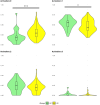Emotional speech markers of psychiatric disturbance in Huntington's disease
- PMID: 40873677
- PMCID: PMC12378116
- DOI: 10.3389/fpsyt.2025.1633492
Emotional speech markers of psychiatric disturbance in Huntington's disease
Abstract
Introduction: Psychiatric disorders and difficulties in emotional expression represent a major problem in the management of Huntington's Disease (HD). To improve patient follow-up, we propose to investigate the link between emotional expression and psychiatric symptoms, measured by the Problem Behaviors Assessment (PBA) scale. To this aim we developed the first emotional/psychiatric speech corpus, emoHD.
Methods: We included 102 HD gene carriers and 35 healthy controls (HC). Psychiatric symptoms were assessed using PBA sub-scales for Depression, Irritability/aggressivity, Apathy, and Obsessive/compulsive symptoms. Speech was annotated using three emotional descriptors: primary emotions, affective phenomena, and activation levels. Affective phenomena labels were selected based on PBA statements by external participants unaware of the study's aims. We analyzed (1) emotional descriptors' relationships, (2) emotional expression differences between HD and HC, and (3) the associations between emotions and psychiatric symptoms.
Results: HD patients showed reduced emotional expressiveness than HC with more neutral activation levels (=0). Only the primary emotion "angry" was less expressed in HD compared to HC. In contrast they expressed more affective phenomena states like apathetic, confused, "depressed", "disoriented", "frustrated", and "pessimistic" than HC, whereas they expressed less "other" and "irritable" than HC. Expressed emotions were congruent with psychiatric symptoms (e.g., "anxious" and "nervous" are positively associated with Depression PBA sub-scale; "frustrated" with Irritability/aggressivity PBA sub-scale).
Conclusion: We showed that speech is a promising marker for emotional/psychiatric symptoms in HD, supporting future remote monitoring and personalized care strategies.
Keywords: Huntington’s disease; emotional expression; psychiatric symptoms; remote monitoring; speech analysis.
Copyright © 2025 Chenain, Fabre, Titeux, Morgado, Youssov, Clavel and Bachoud-Lévi.
Conflict of interest statement
The authors declare that the research was conducted in the absence of any commercial or financial relationships that could be construed as a potential conflict of interest.
Figures







Similar articles
-
Prescription of Controlled Substances: Benefits and Risks.2025 Jul 6. In: StatPearls [Internet]. Treasure Island (FL): StatPearls Publishing; 2025 Jan–. 2025 Jul 6. In: StatPearls [Internet]. Treasure Island (FL): StatPearls Publishing; 2025 Jan–. PMID: 30726003 Free Books & Documents.
-
Facial emotion recognition accuracy in women with symptoms of polycystic ovary syndrome: Reduced fear and disgust perception.Womens Health (Lond). 2025 Jan-Dec;21:17455057251359761. doi: 10.1177/17455057251359761. Epub 2025 Jul 28. Womens Health (Lond). 2025. PMID: 40726090 Free PMC article.
-
An Examination of Perceived Stress and Emotion Regulation Challenges as Mediators of Associations Between Camouflaging and Internalizing Symptomatology.Autism Adulthood. 2024 Sep 16;6(3):345-361. doi: 10.1089/aut.2022.0121. eCollection 2024 Sep. Autism Adulthood. 2024. PMID: 39371362
-
The Black Book of Psychotropic Dosing and Monitoring.Psychopharmacol Bull. 2024 Jul 8;54(3):8-59. Psychopharmacol Bull. 2024. PMID: 38993656 Free PMC article. Review.
-
Signs and symptoms to determine if a patient presenting in primary care or hospital outpatient settings has COVID-19.Cochrane Database Syst Rev. 2022 May 20;5(5):CD013665. doi: 10.1002/14651858.CD013665.pub3. Cochrane Database Syst Rev. 2022. PMID: 35593186 Free PMC article.
References
-
- Hayes CJ, Stevenson RJ, Coltheart M. Production of spontaneous and posed facial expressions in patients with Huntington’s disease: Impaired communication of disgust. Cogn Emotion. (2009) 23:118–34. doi: 10.1080/02699930801949090 - DOI
LinkOut - more resources
Full Text Sources

